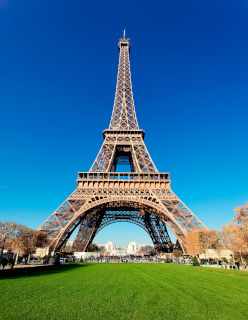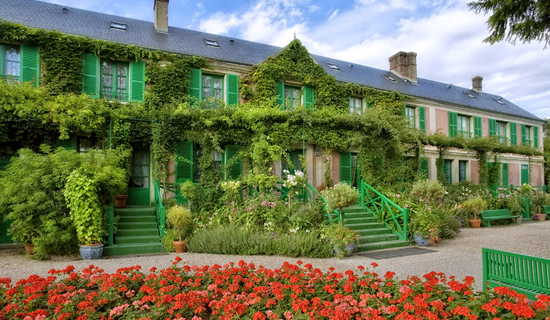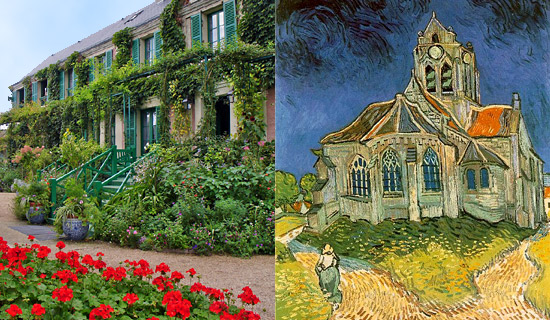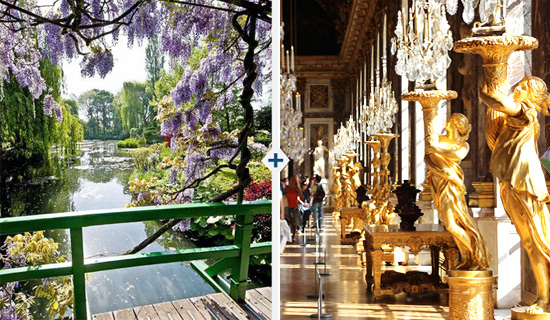Claude Monet and Giverny
Welcome to the world of Claude Monet, painter and gardener. For over forty years, until his death in 1926, Giverny was his home, his place of creation, and his work he transformed neglected area with floral work.
Passionate about gardening as much as by the colors he designed his flower garden and water garden as true works. Walking in his garden and his house, you still feel the atmosphere in the master of Impressionism marveling at what was his greatest inspiration. The gardens consist of the Clos Normand and its flower beds and water garden planted with oriental plants and weeping willows, with its Japanese bridge painted green and water lilies.
Lovers of Impressionist painting will be delighted to spend a half day or a day exploring Giverny, picturesque small country town. Visit the home of the undisputed master of this style of painting, Claude Monet, whose fairy gardens have inspired some of his most famous paintings.
Enjoy the scenery that awaits you during the 90 minutes of the journey that takes you out of Paris and timeless at the time of the painters of the nineteenth century. Stroll through the beautiful village of Giverny and discover for yourself the incredible gardens that so inspired the great artist who loved them so much.
Stroll at your leisure in the beautifully restored house and workshop, and in the serenity of the park where you can admire the pond and the Japanese bridge legendary. You will soon understand that Monet found inspiration for his most iconic works including Water Lilies.
This tour will not leave you unmoved. You will feel the atmosphere in the master of Impressionism and you marvel at these compositions of flowers and colors. These gardens offer a pleasing spectacle from April to October. In bloom without slack period : tulips, iris, wisteria, roses and lilies...
The house of Monet at Giverny
On entering the house of Monet, you must imagine the house echoing footsteps of the eight children, the whereabouts of Claude Monet between his studio and garden, the atmosphere in the kitchen in the morning when vegetables arriving fresh from the garden, market returns, arrivals friends from Paris...
ON THE GROUND FLOOR : the "Blue Room", "grocery", the living-workshop.
The tour begins with the reading lounge also called "small blue room" which communicates with the "grocery store" where were stored tea, olive oil, spices and eggs in furniture hanging on the wall.
Then enters the first workshop of the artist, where he worked until 1899 and which was the subject of a reconstitution in 2011. Initiated by Hugues R. Gall, the reconstitution of the living-workshop in the house of the painter benefited the generous sponsorship of the Versailles Foundation. Under the scientific direction of Sylvie Patin, correspondent of the Academy of Fine Arts and author of numerous works on Impressionism, the provision of the living-workshop approaching that time of Claude Monet. Sixty paintings were selected to be replicated. These replicas are now presented on the picture rails of the living-workshop in a dense snap to find the atmosphere of yesteryear, in the interests of respect for historical truth.
FIRST FLOOR : the private apartments
A first staircase leads upstairs which serves private parts. First, we discover Monet's room which was in 2013 the subject of a meticulous reconstruction scenic. Objects and pictorial works are present in the room and the adjoining bathroom from the lifetime of Monet, including paintings reproductions of his friends: Cézanne, Renoir, Signac and Caillebotte.
The tour continues by Monet's bathroom, that of Alice and her room, which overlooks a tiny room designed for sewing. damask tablecloths sewn together line the walls of the two rooms.
Finally, last of the rooms upstairs, the bedroom White Hoschedé - Monet
was opened to the public for the first time in 2014. As for Monet's room, scenic reconstruction work was carried out by Hubert Le Gall, who was inspired interiors of time to return closer the instead of life which remained in Giverny until his death in 1947.
ON THE GROUND FLOOR : The dining room, the kitchen
The dining room of the house has been restored in every detail. On the yellow walls, you can admire the collection of Japanese prints. The yellow painted furniture were then very modern for the time. In the windows, one can see the blue faience tableware, yellow and blue service that Monet had to do for the holidays. In the kitchen to Rouen with blue tiles, the huge stove with multiple furnaces and copper utensils seem to await the return of their owners.
Monet's gardens
THE WATER GARDEN AT GIVERNY
In 1893, ten years after his arrival at Giverny, Monet bought the property that neighboring his property on the other side of the railway track. It is crossed by a small stream, Ru, a branch of the Epte. Despite opposition from neighboring farmers who fear that poisons the water by planting bizarre plants, but with the support of the Prefecture, Monet dug a small pond first.
Eventually the pool will be expanded to reach today's proportions. The water garden while asymmetries and curves inspired by Japanese gardens that Monet knew from the prints he is an avid collector. Since the 1867 World Fair where Japan is represented for the first time, Claude Monet developed a passion for the land of the rising sun. It quickly becomes a great lover of prints that hang around his house.
Found in this water garden the famous Japanese bridge covered with wisteria, other smaller bridges, weeping willows, a bamboo forest, especially the famous nympheas that bloom all summer. The pool and surrounding vegetation form an enclosure separated from the surrounding countryside.
THE JAPANESE BRIDGE
In 1895, a wooden bridge was added to the pond water garden and gradually takes the name of Japanese bridge, because of the arrangement of the garden, reminiscent of an oriental garden. But note that the exuberance of the vegetation is more likely to Mediterranean gardens that the Japanese tradition, and that, moreover, the decks of Japanese gardens are traditionally red. But Monet decided to paint the green to make it blend with the surrounding greenery. Made of beech wood, it will be a great inspiration for the paintings of the artist, for the charm of its curves produces a special effect on the surface of the water, between reflection and play of light rays from the the sun that give a different aesthetic of the time of day.
The first canvases, painted along an east-west, show the foreground pool and deck at the rear. In 1899, a new series of 12 paintings shown, this time, since the release of the basin. The format is close to a square of 90 cm. The framework has tightened cutting both ends of the bridge but the view remains the same, Monet was standing in the same place to paint.
Monet painted his bridge a grand total of 45 times ! To build it uses a local craftsman. At the time of the restoration of the garden the bridge was too damaged to be recoverable. It had to be rebuilt by a company in Vernon. It is entirely made of beech wood. Today, one can find the exact position it occupied on the shore of the pond to paint the bridge, and the wisteria that always cover the were planted by Monet himself.
THE "CLOS NORMAND"
When Monet moved to Giverny, the longhouse pink plaster has a hectare garden consists of an apple orchard and a vegetable garden. A great avenue of cypress and spruce leads from the gate to the front door, and mass are bordered by box trees. Love this garden, the painter - gardener starts to work immediately and will constantly improve the Clos Normand to make the garden colorful dreams.
He snatch the box and after long disputes with his wife Alice, he cut spruce which she liked so much and replaces them with metal poles, still in place today. The central path bordered with nasturtiums and fragrant roses, which continue to amaze visitors. The apple trees are replaced with cherry and apricot Japan and flowers cover the ground by thousands : daffodils, tulips, daffodils, iris, oriental poppies, peonies...
Passionate about gardening, the painter applies his pictorial skills to create effects of perspectives, enhancing the home or intensify the shadows. On the left side of the garden, it creates massive rectangular solid colors, such as colors put on a pallet... Inventive in his garden as he was in his painting, this "crazy flower" has created a garden solar, which thanks to the talent of the current gardeners, found each year all its magic.
The Museum of Impressionism in Giverny
In May 2009, the American Art Museum of Giverny, established in 1992, is Museum of Impressionism. Claude Monet Giverny particularly fond. Garden inspired the leader of the artistic movement, this beautiful corner of Normandy which already hosts the house of the artist and the Monet Foundation, dedicated a museum to Impressionism.
The primary purpose of the Museum of Impressionism Giverny is to highlight the international nature of the Impressionist movement, especially the colony of Giverny or the Seine Valley. The museum focuses on the history of Impressionism, Post-Impressionism as a whole, and its earliest suites in the second half of the twentieth century.







